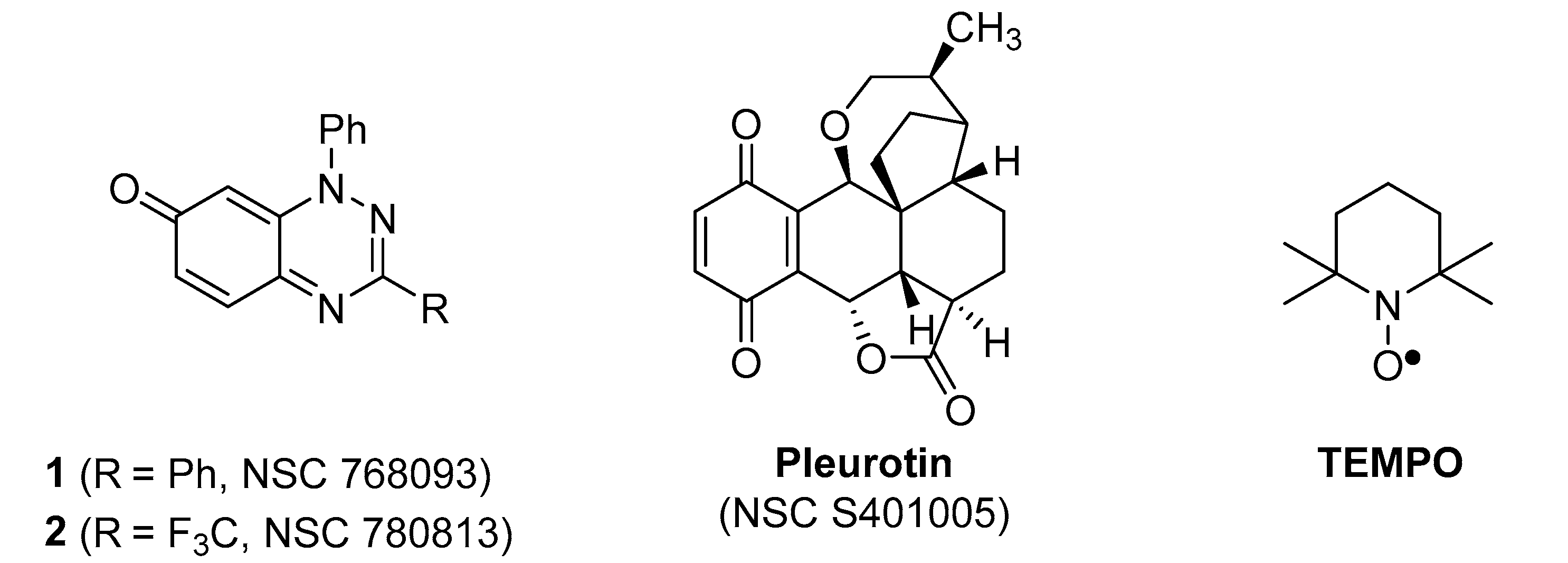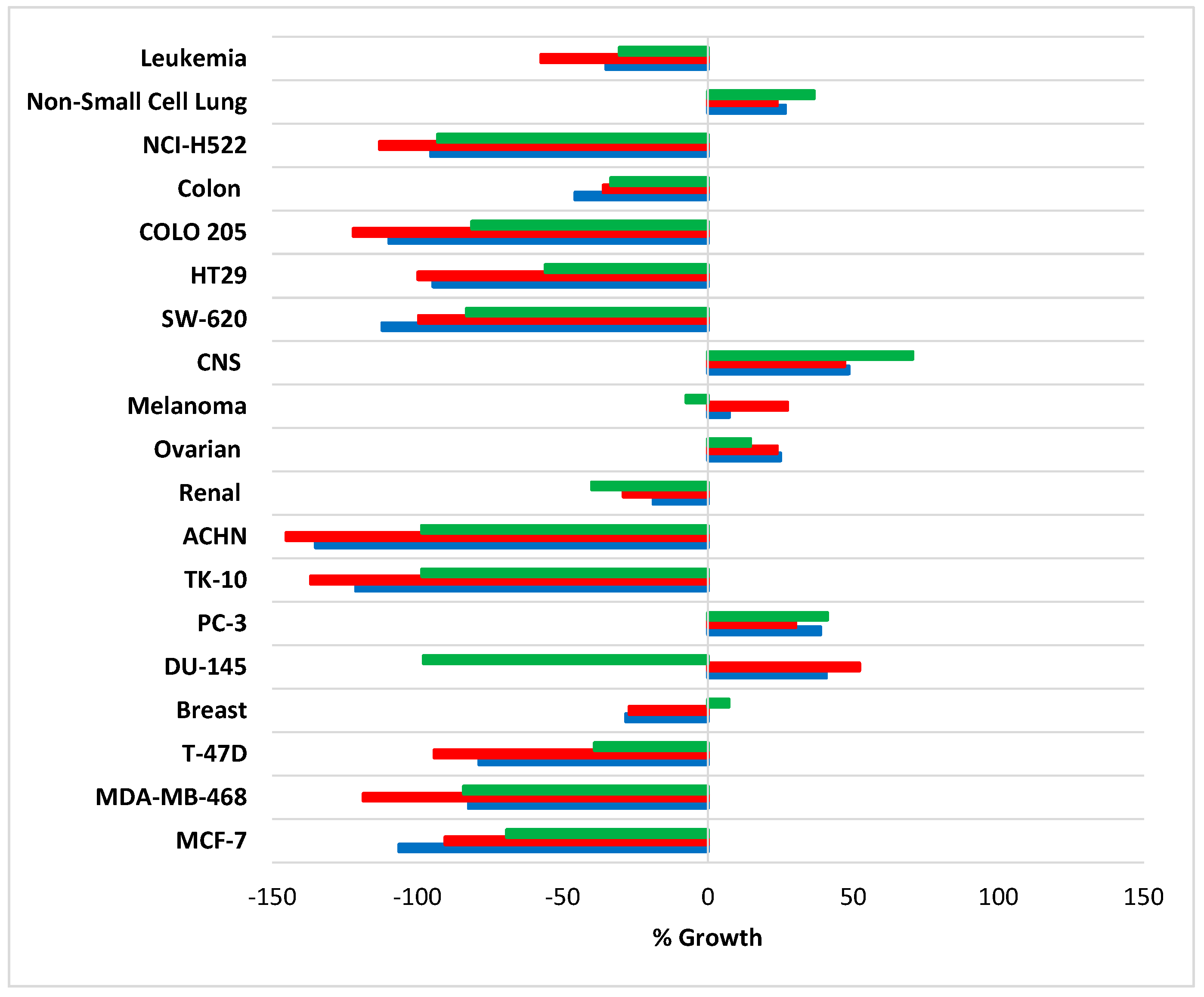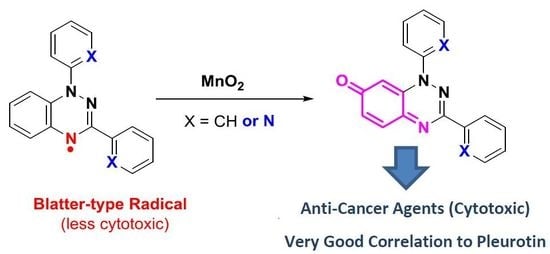Anti-Cancer Activity of Phenyl and Pyrid-2-yl 1,3-Substituted Benzo[1,2,4]triazin-7-ones and Stable Free Radical Precursors
Abstract
:1. Introduction
2. Results and Discussion
2.1. Synthesis of Pyrid-2-yl-Substituted Benzo[1,2,4]triazin-7-ones
2.2. Development Therapeutic Program (DTP) National Cancer Institute (NCI) 60 Human Tumor Cell Line Screen and COMPARE Analysis
2.3. Cytotoxicity against DU-145 and MCF-7 Cell Lines Using the MTT Assay
3. Experimental Section
3.1. General Procedures
3.2. Synthesis of Phenyl- and Pyrid-2-yl-Substituted Benzo[1,2,4]triazin-7-ones 4a and 4b
3.3. Cell Culture and Cytotoxicity Evaluation
3.3.1. Materials and Cell Lines
3.3.2. Cytotoxicity Measurements Using the MTT Assay
4. Conclusions
Supplementary Materials
Acknowledgments
Author Contributions
Conflicts of Interest
References
- Sweeney, M.; Coyle, R.; Kavanagh, P.; Berezin, A.A.; Lo Re, D.; Zissimou, G.A.; Koutentis, P.A.; Carty, M.P.; Aldabbagh, F. Discovery of anti-cancer activity for benzo[1,2,4]triazin-7-ones: Very strong correlation to pleurotin and thioredoxin reductase inhibition. Bioorg. Med. Chem. 2016, 24, 3565–3570. [Google Scholar] [CrossRef] [PubMed]
- Catto, M.; Berezin, A.A.; Lo Re, D.; Loizou, G.; Demetriades, M.; De Stradis, A.; Campagna, F.; Koutentis, P.A.; Carotti, A. Design, synthesis and biological evaluation of benzo[e][1,2,4]triazin-7(1H)-one and [1,2,4]-triazino[5,6,1-jk]carbazol-6-one derivatives as dual inhibitors of β-amyloid aggregation and acetyl/butyryl cholinesterase. Eur. J. Med. Chem. 2012, 58, 84–97. [Google Scholar] [CrossRef] [PubMed]
- Koutentis, P.A.; Lo Re, D. Catalytic oxidation of N-phenylamidrazones to 1,3-diphenyl-1,4-dihydro-1,2,4-benzotriazin-4-yls: An improved synthesis of Blatter’s radical. Synthesis 2010, 2075–2079. [Google Scholar] [CrossRef]
- Suy, S.; Mitchell, J.B.; Ehleiter, D.; Haimovitz-Friedman, A.; Kasid, U. Nitroxides tempol and tempo induce divergent signal transduction pathways in MDA-MB 231 breast cancer cells. J. Biol. Chem. 1998, 273, 17871–17878. [Google Scholar] [CrossRef] [PubMed]
- Suy, S.; Mitchell, J.B.; Samuni, A.; Mueller, S.; Kasid, U. Nitroxide Tempo, a small molecule, induces apoptosis in prostate carcinoma cells and suppresses tumor growth in athymic mice. Cancer 2005, 103, 1302–1313. [Google Scholar] [CrossRef] [PubMed]
- Garuti, L.; Roberti, M.; Malagoli, M.; Rossi, T.; Castelli, M. Synthesis and antiproliferative activity of some benzimidazole-4,7-dione derivatives. Bioorg. Med. Chem. Lett. 2000, 10, 2193–2195. [Google Scholar] [CrossRef]
- Moriarty, E.; Carr, M.; Bonham, S.; Carty, M.P.; Aldabbagh, F. Synthesis and toxicity towards normal and cancer cell lines of benzimidazolequinones containing aromatic rings and 2-aromatic ring substituents. Eur. J. Med. Chem. 2010, 45, 3762–3769. [Google Scholar] [CrossRef] [PubMed]
- Dam, J.; Ismail, Z.; Kurebwa, T.; Gangat, N.; Harmse, L.; Marques, H.M.; Lemmerer, A.; Bode, M.L.; de Koning, C.B. Synthesis of copper and zinc 2-(pyridine-2-yl)imidazo[1,2-a]pyridine complexes and their potential anti-cancer activity. Eur. J. Med. Chem. 2017, 126, 353–368. [Google Scholar] [CrossRef] [PubMed]
- Berezin, A.A.; Zissimou, G.; Constantinides, C.P.; Beldjoudi, Y.; Rawson, J.M.; Koutentis, P.A. Route to benzo- and pyrido-fused 1,2,4-triazinyl radicals via N′-(het)aryl-N′′-[2-nitro(het)aryl]hydrazides. J. Org. Chem. 2014, 79, 314–327. [Google Scholar] [CrossRef] [PubMed]
- Fagan, V.; Bonham, S.; Carty, M.P.; Saenz-Méndez, P.; Eriksson, L.A.; Aldabbagh, F. COMPARE analysis of the toxicity of an iminoquinone derivative of imidazo[5,4-f]benzimidazoles with NAD(P)H:quinone oxidoreductase 1 (NQO1) activity and computational docking of quinones as NQO1 substrates. Bioorg. Med. Chem. 2012, 20, 3223–3232. [Google Scholar] [CrossRef] [PubMed]
- Mosmann, T. Rapid colorimetric assay for cellular growth and survival: Application to proliferation and cytotoxicity assays. J. Immunol. Methods 1983, 65, 55–63. [Google Scholar] [CrossRef]
- Skehan, P.; Storeng, R.; Scudiero, D.; Monks, A.; McMahon, J.; Warren, J.T.; Bokesch, H.; Kenney, S.; Boyd, M.R. New colorimetric cytotoxicity assay for anti-cancer screening. J. Natl. Cancer Inst. 1990, 82, 1107–1112. [Google Scholar] [CrossRef] [PubMed]
- Keepers, Y.P.; Pizao, P.E.; Peters, G.J.; Van Ark-Otte, J.; Winograd, B.; Pinedo, H.M. Comparison of the sulforhodamine B protein and tetrazolium (MTT) assays for in vitro chemosensitivity testing. Eur. J. Cancer 1991, 27, 897–900. [Google Scholar] [CrossRef]
- Harwood, L.M. Dry-column flash chromatography. Aldrichimica Acta 1985, 18, 25. [Google Scholar]
Sample Availability: Samples of the compounds within are available from the authors (or from MDPI). |



| Compound | IC50 DU-145 (µM) | IC50 MCF-7 (µM) |
|---|---|---|
| 1 | 3.388 | 0.295 |
| 4a | 27.542 | 3.388 |
| 4b | 5.248 | 1.348 |
| Compound | Pleurotin |
|---|---|
| 1 | 0.841 |
| 4a | 0.842 |
| 4b | 0.730 |
| Compound | IC50 DU-145 (µM) | IC50 MCF-7 (µM) |
|---|---|---|
| 1 | 0.230 ± 0.03 | 0.810 ± 0.08 |
| TEMPO | 151.400 ± 7.480 | >999 |
| 3a | 3.140 ± 0.179 | 34.740 ± 6.236 |
| 3b | 3.177 ± 0.154 | 26.415 ± 2.538 |
| 4a | 0.245 ± 0.003 | 0.303 ± 0.009 |
| 4b | 0.241 ± 0.011 | 0.277 ± 0.002 |
© 2018 by the authors. Licensee MDPI, Basel, Switzerland. This article is an open access article distributed under the terms and conditions of the Creative Commons Attribution (CC BY) license (http://creativecommons.org/licenses/by/4.0/).
Share and Cite
Keane, L.-A.J.; Mirallai, S.I.; Sweeney, M.; Carty, M.P.; Zissimou, G.A.; Berezin, A.A.; Koutentis, P.A.; Aldabbagh, F. Anti-Cancer Activity of Phenyl and Pyrid-2-yl 1,3-Substituted Benzo[1,2,4]triazin-7-ones and Stable Free Radical Precursors. Molecules 2018, 23, 574. https://doi.org/10.3390/molecules23030574
Keane L-AJ, Mirallai SI, Sweeney M, Carty MP, Zissimou GA, Berezin AA, Koutentis PA, Aldabbagh F. Anti-Cancer Activity of Phenyl and Pyrid-2-yl 1,3-Substituted Benzo[1,2,4]triazin-7-ones and Stable Free Radical Precursors. Molecules. 2018; 23(3):574. https://doi.org/10.3390/molecules23030574
Chicago/Turabian StyleKeane, Lee-Ann J., Styliana I. Mirallai, Martin Sweeney, Michael P. Carty, Georgia A. Zissimou, Andrey A. Berezin, Panayiotis A. Koutentis, and Fawaz Aldabbagh. 2018. "Anti-Cancer Activity of Phenyl and Pyrid-2-yl 1,3-Substituted Benzo[1,2,4]triazin-7-ones and Stable Free Radical Precursors" Molecules 23, no. 3: 574. https://doi.org/10.3390/molecules23030574







